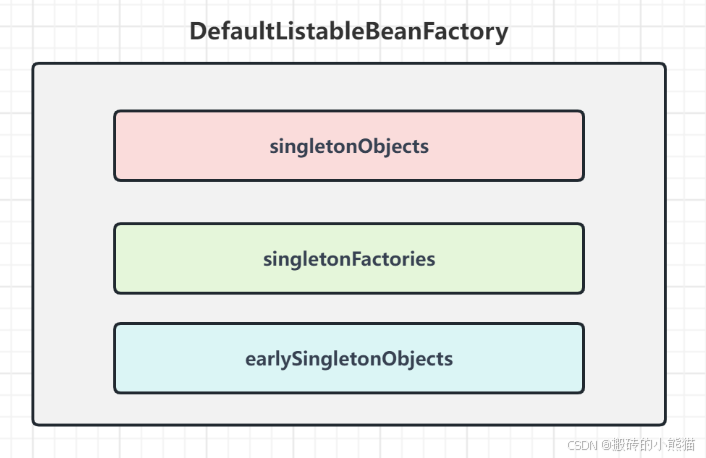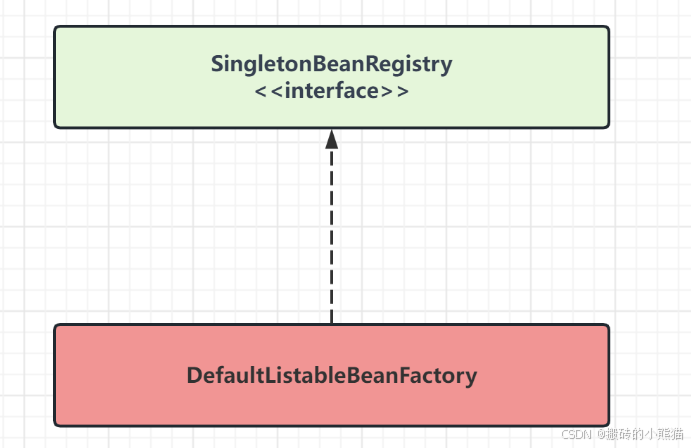1. DefaultListableBeanFactory
在Spring中,所有由Spring容器管理的Bean默认都是单例的。Spring框架中最经典的单例模式实现是在BeanFactory中。BeanFactory是Spring IoC容器的核心接口,其实现类DefaultListableBeanFactory在加载Bean定义时,会将单例的Bean实例化并缓存在ConcurrentHashMap中,以保证该Bean的唯一性。

DefaultListableBeanFactory定义了三个Map对象:singletonObjects、singletonFactories和earlySingletonObjects,它们都被设计为线程安全的ConcurrentHashMap。
-
singletonObjects用于存储已经实例化的单例Bean对象。
-
singletonFactories用于存储BeanFactory对象。
-
earlySingletonObjects用于存储未完全初始化的Bean对象。
当一个单例Bean实例被获取时,DefaultListableBeanFactory会首先检查singletonObjects是否存在该Bean实例,如果存在则直接返回,否则就从earlySingletonObjects或singletonFactories中获取或创建该Bean实例。
2. SingletonBeanRegistry
单例相关的操作其实是被定义在SingletonBeanRegistry接口中。SingletonBeanRegistry是Spring框架中的一个接口,定义了向Spring IoC容器中添加和获取单例Bean的方法。

public interface SingletonBeanRegistry {
void registerSingleton(String var1, Object var2);
@Nullable
Object getSingleton(String var1);
boolean containsSingleton(String var1);
String[] getSingletonNames();
int getSingletonCount();
Object getSingletonMutex();
}
3. Spring单例Bean与单例模式的区别
Spring单例Bean与单例模式的区别在于它们关联的环境不一样,单例模式是指在一个JVM进程中仅有一个实例,而Spring单例是指一个Spring Bean容器(ApplicationContext)中仅有一个实例。
首先看单例模式,在一个JVM进程中(理论上,一个运行的JAVA程序就必定有自己一个独立的JVM)仅有一个实例,无论在程序中的何处获取实例,始终都返回同一个对象。以Java内置的Runtime为例,下面的判断始终为真:
Runtime.getRuntime() == Runtime.getRuntime();
与此相比,Spring的单例Bean是与其容器 ApplicationContext密切相关的,所以在一个JVM进程中,如果有多个Spring容器,即使是单例bean,也一定会创建多个实例,代码示例如下:
public static void main(String[] args) {
System.out.println(Runtime.getRuntime() == Runtime.getRuntime());
ClassPathXmlApplicationContext context_1 = new ClassPathXmlApplicationContext("bean.xml");
Person msb1 = context_1.getBean("person", Person.class);
ClassPathXmlApplicationContext context_2 = new ClassPathXmlApplicationContext("bean.xml");
Person msb2 = context_2.getBean("person", Person.class);
System.out.println(msb1 == msb2);
}
以下是Spring的配置文件:
<bean id="person" class="com.mashibing.spring01.demo03.Person" scope="singleton">
<constructor-arg name="username">
<value>mashibing</value>
</constructor-arg>
</bean>
如果不指定bean的类型,Spring框架生成的Bean默认就是单例的(在当前容器里)。
Spring的单例Bean与Spring Bean管理容器密切相关,每个容器都会创建自己独有的实例,所以与GOF设计模式中的单例模式相差极大,但在实际应用中,如果将对象的生命周期完全交给Spring管理(不在其他地方通过new、反射等方式创建),其实也能达到单例模式的效果。


